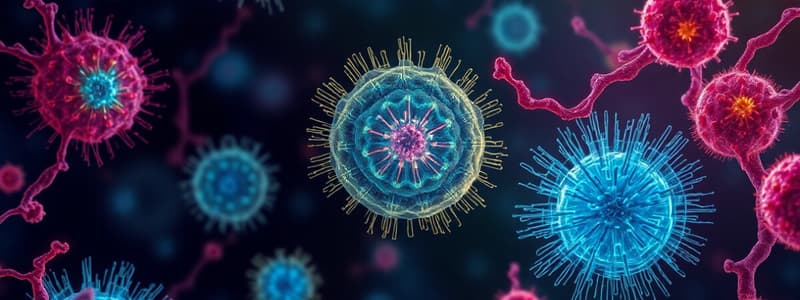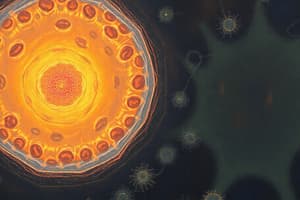Podcast
Questions and Answers
Which statement accurately describes a distinguishing feature of prokaryotic cells?
Which statement accurately describes a distinguishing feature of prokaryotic cells?
- Prokaryotic cells are more complex than eukaryotic cells.
- Prokaryotic cells contain membrane-bound organelles.
- Prokaryotic cells are smaller and simpler than eukaryotic cells. (correct)
- Prokaryotic cells have a nucleus.
What is the primary function of the Golgi Apparatus in a cell?
What is the primary function of the Golgi Apparatus in a cell?
- Replicate DNA.
- Produce ATP.
- Synthesize proteins.
- Modify, sort, and package proteins and lipids. (correct)
During which phase of the cell cycle does DNA replication occur?
During which phase of the cell cycle does DNA replication occur?
- M phase.
- G2 phase.
- S phase. (correct)
- G1 phase.
Which mechanism requires energy to move substances across the cell membrane?
Which mechanism requires energy to move substances across the cell membrane?
What type of cellular respiration occurs in the absence of oxygen?
What type of cellular respiration occurs in the absence of oxygen?
Which organelle is primarily responsible for the synthesis of lipids?
Which organelle is primarily responsible for the synthesis of lipids?
Which process results in genetically diverse cells?
Which process results in genetically diverse cells?
What term is used to describe the breakdown of larger molecules to release energy?
What term is used to describe the breakdown of larger molecules to release energy?
What is the term for the semi-permeable barrier that regulates the entry and exit of substances in a cell?
What is the term for the semi-permeable barrier that regulates the entry and exit of substances in a cell?
Which of the following statements is NOT part of cell theory?
Which of the following statements is NOT part of cell theory?
Flashcards are hidden until you start studying
Study Notes
Cell Biology
Basic Unit of Life
- Cells are the fundamental units of life.
- All living organisms are composed of cells.
- Two main types of cells: prokaryotic and eukaryotic.
Prokaryotic Cells
- Lack a nucleus and membrane-bound organelles.
- Smaller and simpler than eukaryotic cells.
- Genetic material is located in a nucleoid region.
- Examples: Bacteria and Archaea.
Eukaryotic Cells
- Contain a true nucleus and membrane-bound organelles.
- Larger and more complex than prokaryotic cells.
- Types: Plant cells, animal cells, fungal cells, and protist cells.
Cell Structure and Organelles
- Nucleus: Contains DNA, controls cell activities.
- Mitochondria: Powerhouse of the cell, site of ATP production.
- Ribosomes: Protein synthesis.
- Endoplasmic Reticulum (ER):
- Rough ER: Studded with ribosomes, synthesizes proteins.
- Smooth ER: Synthesizes lipids, detoxifies.
- Golgi Apparatus: Modifies, sorts, and packages proteins and lipids.
- Lysosomes: Contain digestive enzymes for waste processing.
- Cell Membrane: Semi-permeable barrier, regulates entry and exit of substances.
- Cytoplasm: Jelly-like fluid, site of metabolic processes.
Cell Division
- Mitosis: Process of somatic cell division, results in two identical daughter cells.
- Meiosis: Process of gamete formation, results in four genetically diverse cells.
Cellular Metabolism
- Catabolism: Breakdown of molecules to obtain energy.
- Anabolism: Building up of molecules, requires energy.
- Cellular Respiration: Conversion of glucose and oxygen into ATP, carbon dioxide, and water.
Cell Communication
- Cells communicate through chemical signals (hormones, neurotransmitters).
- Receptors on cell surfaces detect signals and initiate responses.
Transport Mechanisms
- Passive Transport: Movement of molecules without energy (e.g., diffusion, osmosis).
- Active Transport: Movement of molecules against a concentration gradient, requires energy (e.g., sodium-potassium pump).
Cell Cycle
- Composed of interphase (G1, S, G2) and mitotic phase (M).
- Regulation by checkpoints to ensure proper division and function.
Specialization and Differentiation
- Cells can differentiate into specialized types (e.g., muscle cells, nerve cells) based on gene expression and environmental factors.
Cell Theory
- All living things are made of cells.
- Cells are the basic unit of life.
- All cells arise from pre-existing cells.
Basic Unit of Life
- Cells serve as the fundamental units of all living organisms.
- There are two main categories of cells: prokaryotic and eukaryotic.
Prokaryotic Cells
- Characterized by the absence of a nucleus and membrane-bound organelles.
- Smaller and simpler than eukaryotic cells, facilitating rapid reproduction.
- Genetic material is organized within a nucleoid region.
- Examples include Bacteria and Archaea, which are some of the most ancient life forms.
Eukaryotic Cells
- These cells possess a true nucleus where DNA is stored, along with membrane-bound organelles.
- Larger and more complex, allowing for compartmentalization of cellular processes.
- Include various types such as plant cells (which have cell walls and chloroplasts), animal cells, fungal cells, and protist cells.
Cell Structure and Organelles
- Nucleus: Responsible for housing DNA and regulating cellular activity.
- Mitochondria: Known as the powerhouse, where ATP (energy currency) is generated.
- Ribosomes: Sites of protein synthesis, found free in the cytoplasm or attached to the ER.
- Endoplasmic Reticulum (ER):
- Rough ER: Studded with ribosomes for protein synthesis, involved in processing.
- Smooth ER: Lacks ribosomes, involved in lipid synthesis and detoxification processes.
- Golgi Apparatus: Modifies, sorts, and packages proteins and lipids for secretion or use within the cell.
- Lysosomes: Contain digestive enzymes to break down waste materials and cellular debris.
- Cell Membrane: A semi-permeable barrier regulating the movement of substances in and out of the cell.
- Cytoplasm: A gel-like substance where metabolic processes occur.
Cell Division
- Mitosis results in two identical daughter cells, ensuring equal genetic material distribution.
- Meiosis creates four genetically diverse gametes, essential for sexual reproduction.
Cellular Metabolism
- Catabolism involves the breakdown of complex molecules to release energy.
- Anabolism refers to the synthesis of larger molecules from smaller ones, requiring energy input.
- Cellular Respiration transforms glucose and oxygen into ATP, along with carbon dioxide and water by-products.
Cell Communication
- Cells interact through chemical signals such as hormones and neurotransmitters.
- Cell surface receptors recognize these signals and trigger appropriate responses.
Transport Mechanisms
- Passive Transport occurs without energy expenditure, including processes such as diffusion and osmosis.
- Active Transport requires energy to move substances against their concentration gradients, exemplified by the sodium-potassium pump.
Cell Cycle
- Comprises interphase, divided into G1 (growth), S (DNA synthesis), and G2 (preparation for mitosis), along with the mitotic phase (M).
- Checkpoints throughout the cycle ensure proper cell growth and division processes.
Specialization and Differentiation
- Cells can become specialized types based on gene expression and environmental influences, allowing various functions in multicellular organisms.
Cell Theory
- All living organisms are composed of one or more cells.
- Cells are recognized as the basic unit of life.
- All cells originate from pre-existing cells, establishing continuity in life.
Studying That Suits You
Use AI to generate personalized quizzes and flashcards to suit your learning preferences.




